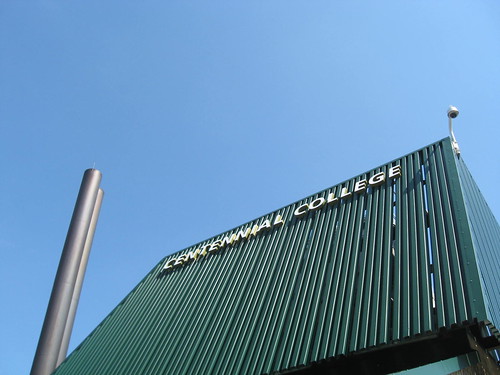
Centennial College was the first of 22 colleges opened under then-Education Minister (and later Premier) Bill Davis’s plan to establish an alternate post-secondary educational option to university in Ontario. Opened in 1966, Centennial was housed in an old munitions factory on Warden Avenue, with 500 students and 14 programs. Although the original Warden Avenue campus closed in 2004, Centennial now has four campuses in Toronto’s east end (in Scarborough and East York), with 30,000 students in 100 full-time or 200 part-time programs. The largest location is the Progress Campus, on Progress Road near Markham Road and Highway 401. The other locations are at Ellesmere Road and Morningside Avenue (the Science and Technology Centre), Warden and Eglinton avenues (The Ashtonbee Campus), and Pape and Mortimer avenues (the Centre for Creative Communications).
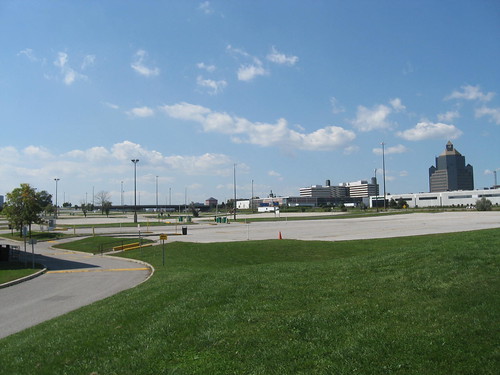
Visiting the Progress Campus, I really started noticing a common but powerful thread among many of Toronto’s schools: they are located next to major highways (Humber’s North Campus is off the 427, Seneca’s Newnham Campus is just east of the DVP, and York’s Keele Street Campus is south of the 407 and East of the 400). Running behind Centennial, the 401 leaves an indelible impression of what it must mean to be a student here. The Progress Campus is home to approximately half of Centennial’s full-time student population. It is also the site of the school’s only residence, a converted Howard Johnson (that is also used as a convention centre) that has room for 380 students (about five percent of the full-time students who attend the Progress Campus). I suppose the best and most convenient way to access the campus is by car, an assumption supported by the sprawl of parking lots that sit between the school’s main buildings, and the 401’s grass embankments. When I was going there I drove with a friend; it seemed like the easiest way to get there from where we were and where we needed to go afterward. This convenience factor seems fitting on the campus. It isn’t pretty, but I really question if it was ever meant to be — maybe it was simply meant to be efficient, to collect people as easily as possible (mainly with cars), give them the skills they need, then disseminate them into the work force.
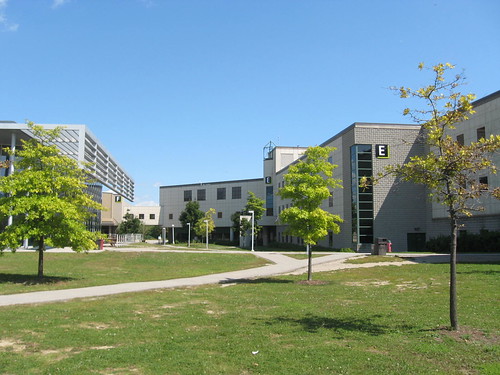
Centennial makes itself convenient by offering very flexible class-times, with core classes being offered at multiple campuses and at different times of the week (including weekends). Centennial also offers staggered starts for many programs throughout the year so that students can work the time more easily into their busy schedules. This is vital to a lot of Centennial’s students, who are older than the average college age, many of whom have families or jobs to consider.
Although core courses are generally offered at the different Centennial locations, each one has their own special features that set them apart. The Ashtonbee Campus is known for the School of Transportation, and has a car garage and aviation hanger. The Centre for Creative Communications is home to the School of Communications, Media and Design, and operates a 16,500 square foot television studio — appropriate, since this facility is where the hit show Degrassi High was filmed. The Centre for Creative Communications also operates a satellite facility, Centennial College @ Wallace Studios, a 44,000 square foot facility that is caters to commercial tenants as well as students, allowing students to learn everything about film, television, and media, while mingling with real-world professionals. The HP Science and Technology Centre, which sits on the Highland Creek watershed near to U of T Scarborough, is more geared towards health sciences and engineering technology programs. Designed by Toronto’s KPMB Architects, the 250,000 square foot HP Science and Technology Centre marks a departure for Centennial away from the conventional, community college typology in favour of something more contemporary and “village-like”.
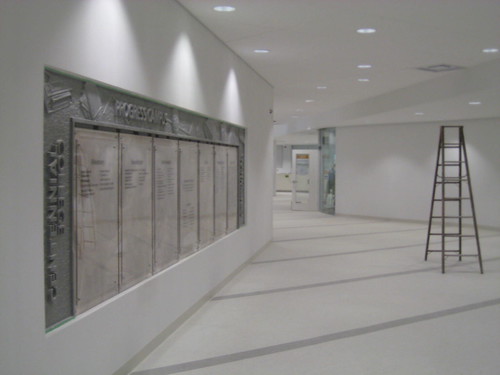
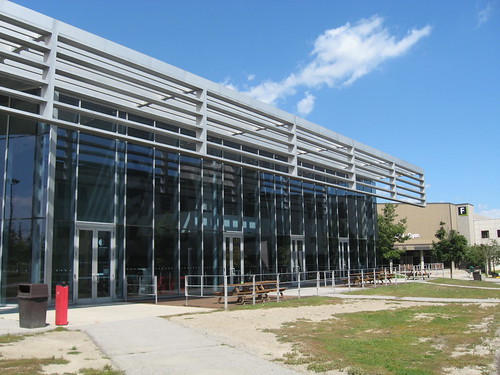
The Progress Campus, being the main facility, offers a wider range of programs including business, child studies, and hospitality. Walking around the Progress Campus wasn’t particularly inspiring, despite the new, glass-clad student centre and the interior renovations to the main classrooms building. The student centre is owned and operated by the student association and has a licensed bar that hosts pub nights and comedy shows. There is also a new athletics facility that is being built which will offer a cricket pitch, rock wall, and yoga/dance studios when it’s complete. There is already an athletics facility at the campus, so I hope that new facility is being planned to sit either on the same site of the existing facility or on one of the many parking lots (when I was there construction had yet to begin so I wasn’t sure where it was going). This reuse of space would help the facility’s agenda to be energy efficient, using alternative fuel sources like wind turbines and solar panels. The facility is meant to incorporate a landscaped courtyard space, sponsored by the Centennial College Alumni Association, acting as a backdrop for ceremonial occasions like convocation. This type of focal point seems like a great idea, because right now the campus seems to lack one.
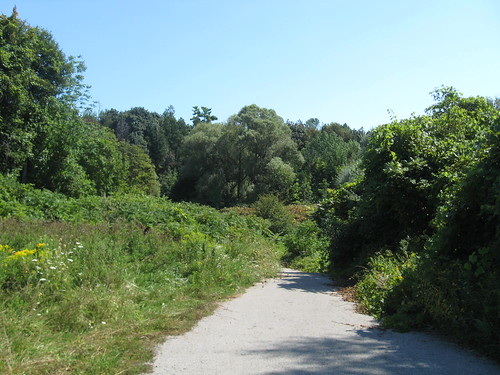
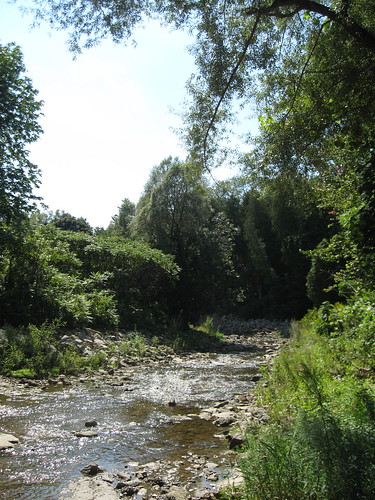
One of the Progress Campus’s best assets is its proximity to a natural creek and woods, Centennial Park, just to the east and down a hill. Coming upon the creek next to the campus was reviving, the trees and water a refreshing counterpoint to the concrete and cars of the school and its surroundings. I wonder if students come down here often, because the area doesn’t look heavily trafficked. The creek just seems like a great place to wander off campus to get away from everything, at least for a few minutes. But being by the creek made me think that at one point the whole area surrounding the campus likely had a similar topography. It is sad to think that so much of it was simply paved over, instead of being creatively incorporated into a concrete-heavy school.

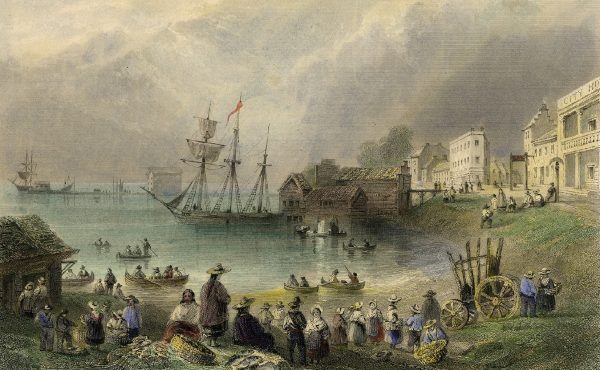
4 comments
I clicked on the School of Transportation link and found zero (0) on public transit. The closest would be the Truck and Coach, but nothing on buses, LRT, streetcars, subways, or trains.
Judging that the main campus requires a car to get to it, it is no surprise.
I wonder if the university has considered restoring now covered portions of the creek or creating more permeable landscapes adjacent to the open creek (as you mention). The campus could gain inspiration from a creek restoration project completed by the University of Virginia (USA). Not only is the project successful in terms of stormwater management but it has been described as “one of the few places where students and residents frequently cross paths” (Landscape Architecture Magazine, August 2008). The Progress Campus is adjacent to residential neighborhoods.
Great post? I actually learned a lot about the college from it and I work there! W. K Lis Progress Campus is actually very public transit accessible with continuous buses running from Town Centre and McCowan Station. Also the GO Bus has a stop at both Progress and Morningside campus. The School of Transportation is located on Warden Avenue so there are plenty of transit choices (Warden Station, which is a few blocks South comes to mind).
Great images as well!
The campus could gain inspiration from a creek restoration project completed by the University of Virginia (USA)